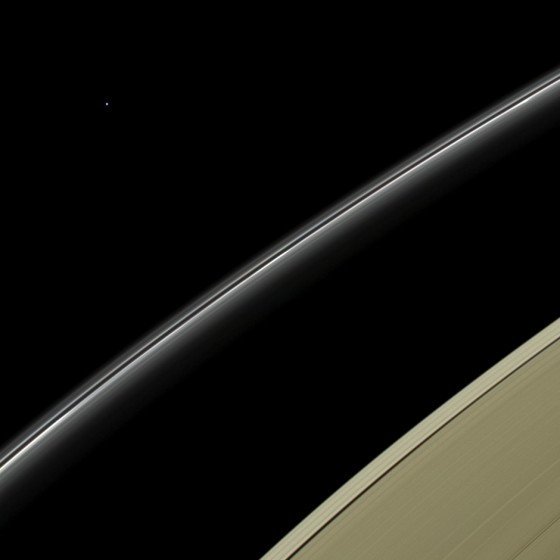Check out Uranus contrasted against the rings of Saturn
Spa-spa-spa-space! It’s not without its humbling glimpses into the perspective of It All. Here’s a pretty sexy image snagged by Cassini that features Uranus against the rings of Saturn.
When you hear the words “pale blue dot” you probably are reminded of the famous quote by Carl Sagan inspired by an image of Earth as a soberingly tiny speck, as imaged by Voyager 1 on February 14th, 1990, from beyond the orbit of Pluto. But there’s another pale blue world in our Solar System: the ice giant Uranus, and its picture was captured much more recently by the Cassini spacecraft from its place in orbit around Saturn on April 11th, 2014.
Uranus’ coloration is a result of methane high in its frigid atmosphere. According to the description on the CICLOPS site, “methane on Uranus — and its sapphire-colored sibling, Neptune — absorbs red wavelengths of incoming sunlight, but allows blue wavelengths to escape back into space, resulting in the predominantly bluish color seen here.”
This was also the first time Uranus had been imaged by the Cassini spacecraft, which has been in orbit around Saturn since 2004.
This image adds one more planet to the list of worlds captured on Camera by Cassini, which made headlines last fall when a glorious mosaic was released that featured a backlit Saturn in eclipse surrounded by its luminous rings, the specks of several of its moons, and the distant dots of Venus, Mars, and the Earth and Moon. Made from 141 separate exposures, the mosaic was captured on July 19th, 2013 — known by many space aficionados as “the day the Earth smiled” as it was the first time the world’s population was alerted beforehand that its picture would be taken from over 900 million miles away.
Saturn — with its terrestrial spacecraft in tow — was about 28.6 AU away from Uranus when the image was acquired. That’s about 4.28 billion kilometers (2.66 billion miles). From that distance the glow of the 51,118-kilometer (31,763-mile) -wide Uranus is reduced to a mere few pixels (which required digital brightening by about 4.5x, as well.) [io9]




